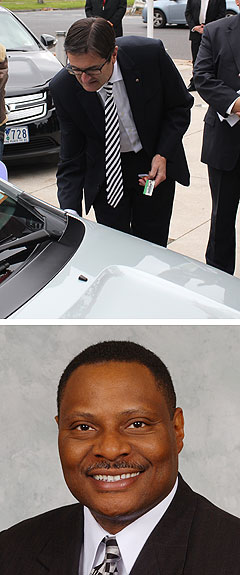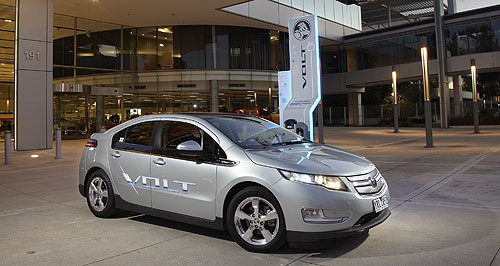Future models - Holden - VoltHolden opens Volt charging stationCharging ahead: Holden has launched a charging station for its Volt range extending electric vehicle which will go on sale by the end of this year. Public charging station at Fishermen’s Bend brings Holden closer to Volt launch16 May 2012 HOLDEN moved a step closer to launching the Volt range-extender electric vehicle with today’s unveiling of a public charging station on the forecourt of its Port Melbourne headquarters. The company joins Nissan and Mitsubishi in installing public charging points at their Australian headquarters, with Nissan setting up charging points for Nissan Leaf drivers at its HQ at Dandenong, Victoria, and Mitsubishi establishing a fast-charger for i-MiEVs at its Tonsley Park offices, in South Australia. A driveway to the charging point gives 24-hour access to Volt customers via a swipe card. Sydney-based EV infrastructure supplier ChargePoint installed six additional charging stations around Holden’s headquarters, as well as the Lang Lang proving ground, all supplied by renewable electricity from Origin Energy. Federal climate change, energy efficiency, industry and innovation minister Greg Combet was driven up to the charging station in a Volt so he could be the first member of the public to plug in a car. He described the Volt as “the motor vehicle of the future that is being delivered now by General Motors”. “It brings together many of the things that we need to meet as a nation in the years ahead – cleaner energy sources, cleaner motor vehicles, advanced engineering work and ensuring we are utilising renewable energy,” he said. “I congratulate the engineering work that General Motors has put into the development of the Volt and I look forward to its take-up within Australia.” Holden’s charger is a level-two 3.3kW unit, which takes less than four hours to recharge the Volt, providing an electric-only range of up to 80km, extended to 600km when the 1.4-litre petrol generator engine kicks in.  From top: Federal minister Greg Combet and Holden engineering executive director Greg Tyus. From top: Federal minister Greg Combet and Holden engineering executive director Greg Tyus.The Volt, which will go on sale in Australia by the end of this year with an expected price of between $50,000 and $60,000, can also be plugged into a standard 10-amp outlet – unlike the i-MiEV and Leaf – which charges it in less than six hours at a cost of about $2.50. No fast charger is available for the Volt, whereas the i-MiEV and Leaf can be topped up to 80 per cent in as little as 30 minutes using a level-4 fast-charger. Holden engineering executive director Greg Tyus described the introduction of the Volt to Australia is one of the most exciting programs his team has had the opportunity to work on. “It relates to energy and energy diversity and requires Holden to understand the way people live, not just how they drive, meaning the company has to understand its customer’s needs in a different way,” he said. Mr Tyus said the prominent charging point on Holden’s forecourt signalled “a new era for the Holden Volt and set to change the way Australians think about sustainable transport and the way they think about Holden”. ChargePoint opened Australia’s first public EV charger in Sydney two years ago. Speaking at the Holden event, ChargePoint CEO James Brown said that since then, Australia’s momentum and speed towards the electrification of transport had been “amazing”, and he praised the way Australia embraced technology “robustly and quickly”. “Launching the Holden Volt will not only see an increase in the uptake of transportation but also a proliferation of smart infrastructure to support it,” he said, adding that EV drivers were likely to increase demand for renewable, environmentally-friendly electricity. “The added demand for green power to supply the Volt and other EVs will provide the basis for additional investment into renewable, green energy. “This is not only a win for the environment but also a win for Australian industry.” ChargePoint has now installed more than 100 public and private recharging stations across Australia, and Mr Brown claimed the Australian network was among the world’s largest in geographical terms. “The network of charge stations starts from Townsville all the way down to Brisbane, Gold Coast, Sunshine Coast, Canberra, Sydney, Adelaide, Melbourne, Tasmania, Adelaide and across to Perth – a truly amazing feat considering the size of the country and the population.” He said the adoption of smart appliances – charging points that can communicate with the customer – will mean “refuelling a car becomes synonymous with parking it”, and that customers can use their smart phone or other internet-enabled device to locate, navigate to and even reserve charging points. The technology automatically alerts the customer via text message or email if their car is accidentally or maliciously unplugged, and the battery charge level can also be monitored remotely. Mr Brown said that unlike rival Better Place, ChargePoint had no intention offering a battery-swap service for compatible cars such as the Renault Fluence ZE.  Read more23rd of February 2012  Holden Volt on pole positionNew re-charging point to take pride of place for Volt at Holden HQAll future models Alfa Romeo Alfa Romeo Abarth Abarth Audi Audi Aston Martin Aston Martin BMW BMW Bentley Bentley Chrysler Chrysler Chevrolet Chevrolet Dodge Dodge Citroen Citroen Ferrari Ferrari DS DS Ford Ford Fiat Fiat FPV FPV Foton Foton Haval Haval Great Wall Great Wall Honda Honda Holden Holden Hyundai Hyundai HSV HSV Isuzu Isuzu Infiniti Infiniti Jeep Jeep Jaguar Jaguar Lamborghini Lamborghini Kia Kia Lexus Lexus Land Rover Land Rover Mazda Mazda Maserati Maserati Mercedes-Benz Mercedes-Benz McLaren McLaren Mini Mini Nissan Nissan Mitsubishi Mitsubishi Peugeot Peugeot Opel Opel Proton Proton Porsche Porsche Renault Renault Ram Ram Saab Saab Rolls-Royce Rolls-Royce Smart Smart Skoda Skoda Subaru Subaru SsangYong SsangYong Tesla Tesla Suzuki Suzuki Toyota Toyota Volvo VolvoMotor industry news |
Click to shareHolden modelsResearch Holden All future models Alfa Romeo Alfa Romeo Abarth Abarth Audi Audi Aston Martin Aston Martin BMW BMW Bentley Bentley Chrysler Chrysler Chevrolet Chevrolet Dodge Dodge Citroen Citroen Ferrari Ferrari DS DS Ford Ford Fiat Fiat FPV FPV Foton Foton Haval Haval Great Wall Great Wall Honda Honda Holden Holden Hyundai Hyundai HSV HSV Isuzu Isuzu Infiniti Infiniti Jeep Jeep Jaguar Jaguar Lamborghini Lamborghini Kia Kia Lexus Lexus Land Rover Land Rover Mazda Mazda Maserati Maserati Mercedes-Benz Mercedes-Benz McLaren McLaren Mini Mini Nissan Nissan Mitsubishi Mitsubishi Peugeot Peugeot Opel Opel Proton Proton Porsche Porsche Renault Renault Ram Ram Saab Saab Rolls-Royce Rolls-Royce Smart Smart Skoda Skoda Subaru Subaru SsangYong SsangYong Tesla Tesla Suzuki Suzuki Toyota Toyota Volvo VolvoMotor industry news |
















Facebook Twitter Instagram